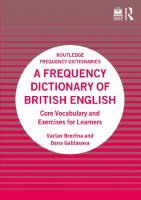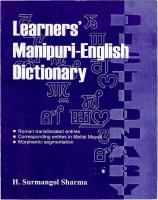A Frequency Dictionary of British English: Core Vocabulary and Exercises for Learners [1 ed.] 1032272716, 9781032272719
A Frequency Dictionary of British English provides information about the frequency and distribution of words in British
140 100 102MB
English Pages 340 [353] Year 2023
Cover
Half Title
Series
Title
Copyright
Dedication
Contents
Series preface
Acknowledgements
Abbreviations
Introduction
Frequency wordlist
Thematic boxes
Alphabetical wordlist
Frequency wordlist according to word classes
New General Service List (New GSL)
Vocabulary exercises
Recommend Papers
File loading please wait...
Citation preview
A Frequency Dictionary of British English
A Frequency Dictionary of British English provides information about the frequency and distribution of words in British English. The dictionary presents rich information about word frequencies and distributions in an accessible manner. In addition to textual and numerical information, the dictionary offers a range of visualisations to help understand the statistical properties of words. These visualisations are especially important for pedagogical uses of the book. This book also includes vocabulary exercises for learners of English to activate their vocabulary with the help of the dictionary. The dictionary is based on extensive research on current British English using the British National Corpus 2014, a 100-million-word corpus of contemporary British English developed at Lancaster University. The corpus represents a wide range of genres/registers of spoken and written English, including informal speech, fiction, newspapers, academic writing and e-language. Additional support materials for this book are available at https://lancslex.lancs.ac.uk. This dictionary is designed to meet the needs of a wide variety of users interested in current British English vocabulary including students, educators, journalists, material developers and researchers. Vaclav Brezina is Professor of Corpus Linguistics at Lancaster University. Dana Gablasova is Senior Lecturer at Lancaster University.
Routledge Frequency Dictionaries
General Editors Paul Rayson, Lancaster University, UK Mark Davies, Brigham Young University, USA Editorial Board Michael Barlow, University of Auckland, New Zealand Sylviane Granger, Université catholique de Louvain, Belgium Barbara Lewandowska-Tomaszczyk, University of Lodz, Poland Josef Schmied, Chemnitz University of Technology, Germany Andrew Wilson, Lancaster University, UK Hongying Tao, University of California at Los Angeles Chris Tribble, King’s College London, UK Scott Crossley, Georgia State University, USA A Frequency Dictionary of Mandarin Chinese Core Vocabulary for Learners Richard Xiao, Paul Rayson, and Tony McEnery A Frequency Dictionary of Korean Core Vocabulary for Learners Sun-Hee Lee, Seok Bae Jang, and Sang Kyu Seo A Frequency Dictionary of Turkish Core Vocabulary for Learners Yes¸im Aksan, Mustafa Aksan, Ümit Mersinli, and Umut Ufuk Demirhan A Frequency Dictionary of Persian Core Vocabulary for Learners Corey Miller and Karineh Aghajanian-Stewart A Frequency Dictionary of Spanish, 2nd Edition Core Vocabulary for Learners Mark Davies and Kathy Hayward Davies A Frequency Dictionary of German, 2nd Edition Core Vocabulary for Learners Erwin Tshirner and Jupp Möhring A Frequency Dictionary of Contemporary Arabic Fiction Core Vocabulary for Learners and Material Developers Laila Familiar A Frequency Dictionary of British English Core Vocabulary and Exercises for Learners Vaclav Brezina and Dana Gablasova For more information about this series, please visit: www.routledge.com/Routledge-Frequency-Dictionaries/ book-series/RFD
A Frequency Dictionary of British English Core Vocabulary and Exercises for Learners Vaclav Brezina and Dana Gablasova
First published 2024 by Routledge 4 Park Square, Milton Park, Abingdon, Oxon OX14 4RN and by Routledge 605 Third Avenue, New York, NY 10158 Routledge is an imprint of the Taylor & Francis Group, an informa business © 2024 Vaclav Brezina and Dana Gablasova The right of Vaclav Brezina and Dana Gablasova to be identified as authors of this work has been asserted in accordance with sections 77 and 78 of the Copyright, Designs and Patents Act 1988. All rights reserved. No part of this book may be reprinted or reproduced or utilised in any form or by any electronic, mechanical, or other means, now known or hereafter invented, including photocopying and recording, or in any information storage or retrieval system, without permission in writing from the publishers. Trademark notice: Product or corporate names may be trademarks or registered trademarks, and are used only for identification and explanation without intent to infringe. British Library Cataloguing-in-Publication Data A catalogue record for this book is available from the British Library Library of Congress Cataloging-in-Publication Data Names: Brezina, Vaclav, 1979- author. | Gablasova, Dana, author. Title: A frequency dictionary of British English : core vocabulary and exercises for learners / Vaclav Brezina, Dana Gablasova. Description: Abingdon, Oxon ; New York, NY : Routledge, 2024. | Series: Routledge frequency dictionaries | Includes bibliographical references. Identifiers: LCCN 2023011541 (print) | LCCN 2023011542 (ebook) | Subjects: LCSH: English language—Word frequency—Dictionaries. | English language—Great Britain—Dictionaries. | LCGFT: Dictionaries. Classification: LCC PE1691 .B696 2024 (print) | LCC PE1691 (ebook) | DDC 423/.1—dc23/eng/20230612 LC record available at https://lccn.loc.gov/2023011541 LC ebook record available at https://lccn.loc.gov/2023011542 ISBN: 978-1-032-27271-9 (hbk) ISBN: 978-1-032-27269-6 (pbk) ISBN: 978-1-003-29204-3 (ebk) DOI: 10.4324/9781003292043 Typeset in Trade Gothic by Apex CoVantage, LLC Access the Support Material: https://lancslex.lancs.ac.uk/
In memory of Geoffrey Leech with gratitude for an early discussion of this project over soup and sandwich.
Contents
Series preface viii
Acknowledgements x
Abbreviations xi
Introduction 1
Frequency wordlist 6
Thematic boxes 173
Alphabetical wordlist 192
Frequency wordlist according to word classes 249
New General Service List (New GSL) 306
Vocabulary exercises 321
Series preface
Frequency information has a central role to play in learning a language. Nation (1990) showed that the 4,000–5,000 most frequent words account for up to 95% of a written text and that the 1,000 most frequent words account for 85% of speech. Although Nation’s results were only for English, they do provide clear evidence that, when employing frequency as a general guide for vocabulary learning, it is possible to acquire a lexicon that will serve a learner well most of the time. There are two caveats to bear in mind here. First, counting words is not as straightforward as it might seem. Gardner (2007) highlights the problems that multiple word meanings, the presence of multiword items and grouping words into families or lemmas have on counting and analysing words. Second, frequency data contained in frequency dictionaries should never act as the only information source to guide a learner. Frequency information is nonetheless a very good starting point that may produce rapid benefits. It therefore seems rational to prioritize learning the words that you are likely to hear and read most often. This is the philosophy behind this series of dictionaries. Lists of words and their frequencies have long been available for teachers and learners of language. For example, Thorndike (1921, 1932) and Thorndike and Lorge (1944) produced word-frequency books with counts of word occurrences in texts used in the education of American children. Michael West’s General Service List of English Words (1953) was primarily aimed at foreign learners of English. More recently, with the aid of efficient computer software and very large bodies of language data (called corpora), researchers have been able to provide more sophisticated frequency counts from both written text and transcribed speech. One important feature of the resulting frequencies presented in this series is that they are derived from recently collected language data. The earlier lists for English included samples from, for example, Austen’s Pride and Prejudice and Defoe’s Robinson Crusoe; thus, they can no longer represent present-day language in any sense. Frequency data derived from a large representative corpus of a language bring students closer to language as they are used in real life as opposed to textbook language (which often distorts the frequencies of features in a language, see Ljung 1990). The information in these dictionaries is presented in a number of formats to allow users access to the data in different ways. So, for example, if you would prefer not to simply drill down through the word frequency list but would rather focus on verbs, the part-of-speech index will allow you to focus on just the most frequent verbs. Given that verbs typically account for 20% of all words in a language, this may be a good strategy. In addition, a focus on function words may be equally rewarding – 60% of speech in English is composed of a mere 50 function words. The series also provides information of use to the language teacher. The idea that frequency information may have a role to play in syllabus design is not new (see, for example, Sinclair & Renouf 1988). However, to date, it has been difficult for teachers of languages other than English to use frequency information in syllabus design because of a lack of data. Frequency information should not be studied to the exclusion of other contextual and situational knowledge about language use, and we may even doubt the validity of frequency information derived from large corpora. It is interesting to note that Alderson (2007) found
Series preface
ix
that corpus frequencies may not match a native speaker’s intuition about estimates of word frequency and that a set of estimates of word frequencies collected from language experts varied widely. Thus, corpus-derived frequencies are still the best current estimate of a word’s importance that a learner will come across. Around the time of the construction of the first machine-readable corpora, Halliday (1971: 344) stated that ‘a rough indication of frequencies is often just what is needed’. Our aim in this series is to provide as accurate as possible estimates of word frequencies. Paul Rayson and Mark Davies Lancaster and Provo, 2008 References
Alderson, J. C. (2007). Judging the frequency of English words. Applied Linguistics, 28(3), 383–409.
Gardner, D. (2007). Validating the construct of word in applied corpus-based vocabulary research: A critical survey.
Applied Linguistics, 28, 241–265. Halliday, M. A. K. (1971). Linguistic functions and literary style. In S. Chatman (ed.) Style: A Symposium. Oxford University Press, Oxford, pp. 330–365. Ljung, M. (1990). A Study of TEFL Vocabulary. Almqvist & Wiksell International, Stockholm. Nation, I. S. P. (1990). Teaching and Learning Vocabulary. Heinle & Heinle, Boston. Sinclair, J. M., & Renouf, A. (1988). A lexical syllabus for language learning. In R. Carter and M. McCarthy (eds.) Vocabulary and Language Teaching. Longman, London, pp. 140–158. Thorndike, E. (1921). Teacher’s Word Book. Columbia Teachers College, New York. Thorndike, E. (1932). A Teacher’s Word Book of 20,000 Words. Columbia University Press, New York. Thorndike, E., & Lorge, I. (1944). The Teacher’s Word Book of 30,000 Words. Columbia University Press, New York. West, M. (1953). A General Service List of English Words. Longman, London.
Acknowledgements
This work was supported by the Economic and Social Research Council (grant number EP/ P001559/1, ES/K002155/1 and ES/R008906/1).
Abbreviations
The following abbreviations are used in this dictionary. abr adj adv avp con conn e
abbreviation adjective adverb adverbial particle in phrasal verbs conjunction connector, that is, preposition or conjunction existential there
mod n prep pron t v x
modal noun preposition pronoun to as infinitive marker verb determiner, quantifier, interjection or particle
Introduction
What is a frequency dictionary?
In this way, they offer a variety of pathways into the
A frequency dictionary provides information about the
material presented in the dictionary.
frequency and distribution of words. This information is essential for both pedagogical and research purposes. This frequency dictionary is based on extensive research on current British English (see ‘Is British English changing?’) by using the British National Corpus 2014, a 100-million-word corpus of contemporary British English developed at Lancaster University (Brezina et al. 2021; Love et al. 2017). The corpus represents a wide range of genres/registers of spoken and written English, including informal speech, fiction, newspapers, academic writing and e-language (see ‘What is the dictionary based on?’).
Who is this dictionary for? This dictionary is designed to meet the needs of a wide variety of users interested in current British English vocabulary including students, educators, journalists, material developers and researchers. The dictionary presents in an accessible manner rich information about word frequencies and distributions. In addition to textual and numerical information, the dictionary offers a range of visualisations to help understand the statistical properties of words. These visualisations are especially important for pedagogical uses of the book. Specifically, frequency distributions of words across genres/registers are visualised in the form of sparklines,
Is British English changing? A short answer to the question posed in the title of this section is ‘yes’. Over time, British English has become more informal, which has been reflected both in its vocabulary and grammar. For instance, we can see a clear effect of online genres/registers such as emails, social media posts and blogposts on the current language use. This effect, however, is not restricted to e-language but also permeates more traditional genres/ registers such as newspapers, magazines, fiction or even academic writing. To reflect current trends in British English, this dictionary uses information available in the British National Corpus 2014, the most up-to-date, large-scale and balanced source of data available for British English (see ‘What is the dictionary based on?’). In many ways, the dictionary updates and considerably extends the information available in Leech et al.’s (2001) Word Frequencies in Written and Spoken English (Routledge), which was based on the British National Corpus 1994, representing the language from and before the early 1990s. Find out more: what are the main trends in current British English?
that is, small graphs (bar charts) of the size of a word,
Brezina (2021) highlights five major areas in which
and selected collocations are displayed as collocation
current British English differs from British English
graphs (see Introduction to Chapter 2). At the end of
used twenty years ago. These include the increase in
Chapter 2, twenty thematic boxes are included, drawing
informal features, such as contractions, the decrease in
users’ attention to semantic fields such as ‘Food and
the use of titles, such as Mr. or Mrs., and modal verbs,
drink’, ‘Money and business’, ‘Climate and weather’
the introduction of specific vocabulary, acronyms and
and other important features such as ‘Punctuation
spellings from e-language and changes in sentence
marks’, ‘Length of words’ and ‘Multi-word expressions’.
structure and punctuation patterns.
To support active engagement with the dictionary, Chapter 6 offers a series of exercises suitable for both beginner and more advanced language learners. The vocabulary exercises are designed to draw users’ attention to different aspects of lexical knowledge with reference to the information included in the dictionary.
To find out more, go to https:// theconversation.com/five-ways-the internet-era-has-changed-british english-new-research-172432 or scan this QR code.
DOI: 10.4324/9781003292043-1
2
A Frequency Dictionary of British English
Frequency or dispersion? This dictionary offers a list of frequent words in British English. This means that the principle
High frequency
Low frequency
(> 279 per million)
(

![A Frequency Dictionary of Russian: Core Vocabulary for Learners [1 ed.]
1317917847](https://ebin.pub/img/200x200/a-frequency-dictionary-of-russian-core-vocabulary-for-learners-1nbsped-1317917847.jpg)





![Oxford American Dictionary Vocabulary Builder: Lessons and activities for English language learners (ELLs) to consolidate and extend vocabulary [Workbook ed.]
0194399958, 9780194399951](https://ebin.pub/img/200x200/oxford-american-dictionary-vocabulary-builder-lessons-and-activities-for-english-language-learners-ells-to-consolidate-and-extend-vocabulary-workbooknbsped-0194399958-9780194399951.jpg)
![Macmillan English Dictionary (for Advanced Learners of American English) [1 ed.]
3999905229, 0333966724](https://ebin.pub/img/200x200/macmillan-english-dictionary-for-advanced-learners-of-american-english-1nbsped-3999905229-0333966724.jpg)

![A Frequency Dictionary of British English: Core Vocabulary and Exercises for Learners [1 ed.]
1032272716, 9781032272719](https://ebin.pub/img/200x200/a-frequency-dictionary-of-british-english-core-vocabulary-and-exercises-for-learners-1nbsped-1032272716-9781032272719.jpg)